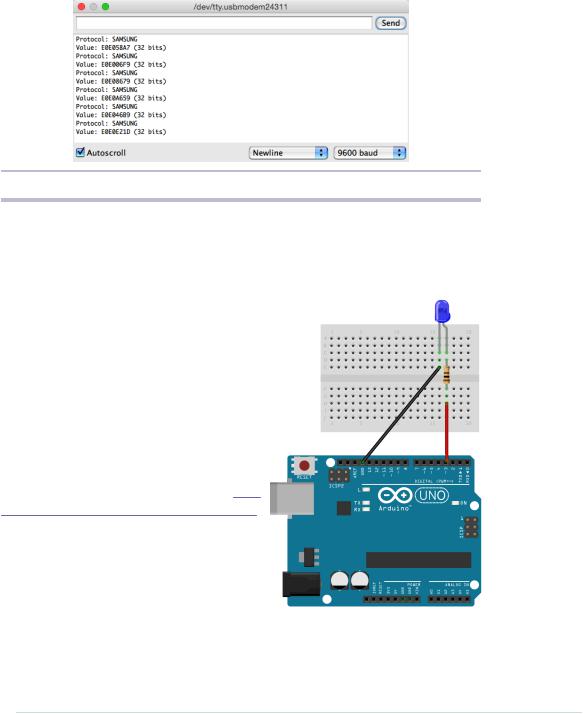
- •Acknowledgments
- •Preface
- •Who Should Read This Book
- •What’s in This Book
- •Arduino Uno and the Arduino Platform
- •Code Examples and Conventions
- •Online Resources
- •The Parts You Need
- •Starter Packs
- •Complete Parts List
- •1. Welcome to the Arduino
- •What You Need
- •What Exactly Is an Arduino?
- •Exploring the Arduino Board
- •Installing the Arduino IDE
- •Meeting the Arduino IDE
- •Hello, World!
- •Compiling and Uploading Programs
- •What If It Doesn’t Work?
- •Exercises
- •2. Creating Bigger Projects with the Arduino
- •What You Need
- •Managing Projects and Sketches
- •Changing Preferences
- •Using Serial Ports
- •What If It Doesn’t Work?
- •Exercises
- •3. Building Binary Dice
- •What You Need
- •Working with Breadboards
- •Using an LED on a Breadboard
- •First Version of a Binary Die
- •Working with Buttons
- •Adding Your Own Button
- •Building a Dice Game
- •What If It Doesn’t Work?
- •Exercises
- •4. Building a Morse Code Generator Library
- •What You Need
- •Learning the Basics of Morse Code
- •Building a Morse Code Generator
- •Fleshing Out the Morse Code Generator’s Interface
- •Outputting Morse Code Symbols
- •Installing and Using the Telegraph Class
- •Publishing Your Own Library
- •What If It Doesn’t Work?
- •Exercises
- •5. Sensing the World Around Us
- •What You Need
- •Measuring Distances with an Ultrasonic Sensor
- •Increasing Precision Using Floating-Point Numbers
- •Increasing Precision Using a Temperature Sensor
- •Creating Your Own Dashboard
- •What If It Doesn’t Work?
- •Exercises
- •What You Need
- •Wiring Up the Accelerometer
- •Bringing Your Accelerometer to Life
- •Finding and Polishing Edge Values
- •Building Your Own Game Controller
- •More Projects
- •What If It Doesn’t Work?
- •Exercises
- •7. Writing a Game for the Motion-Sensing Game Controller
- •Writing a GameController Class
- •Creating the Game
- •What If It Doesn’t Work?
- •Exercises
- •8. Generating Video Signals with an Arduino
- •What You Need
- •How Analog Video Works
- •Building a Digital-to-Analog Converter (DAC)
- •Connecting the Arduino to Your TV Set
- •Using the TVout Library
- •Building a TV Thermometer
- •Working with Graphics in TVout
- •What If It Doesn’t Work?
- •Exercises
- •9. Tinkering with the Wii Nunchuk
- •What You Need
- •Wiring a Wii Nunchuk
- •Talking to a Nunchuk
- •Building a Nunchuk Class
- •Using Our Nunchuk Class
- •Creating Your Own Video Game Console
- •Creating Your Own Video Game
- •What If It Doesn’t Work?
- •Exercises
- •10. Networking with Arduino
- •What You Need
- •Using Your PC to Transfer Sensor Data to the Internet
- •Registering an Application with Twitter
- •Tweeting Messages with Processing
- •Communicating Over Networks Using an Ethernet Shield
- •Using DHCP and DNS
- •What If It Doesn’t Work?
- •Exercises
- •11. Creating a Burglar Alarm with Email Notification
- •What You Need
- •Emailing from the Command Line
- •Emailing Directly from an Arduino
- •Detecting Motion Using a Passive Infrared Sensor
- •Bringing It All Together
- •What If It Doesn’t Work?
- •Exercises
- •What You Need
- •Understanding Infrared Remote Controls
- •Grabbing Remote Control Codes
- •Cloning a Remote
- •Controlling Infrared Devices Remotely with Your Browser
- •Building an Infrared Proxy
- •What If It Doesn’t Work?
- •Exercises
- •13. Controlling Motors with Arduino
- •What You Need
- •Introducing Motors
- •First Steps with a Servo Motor
- •Building a Blaminatr
- •What If It Doesn’t Work?
- •Exercises
- •Current, Voltage, and Resistance
- •Electrical Circuits
- •Learning How to Use a Wire Cutter
- •Learning How to Solder
- •Learning How to Desolder
- •The Arduino Programming Language
- •Bit Operations
- •Learning More About Serial Communication
- •Serial Communication Using Various Languages
- •What Are Google Chrome Apps?
- •Creating a Minimal Chrome App
- •Starting the Chrome App
- •Exploring the Chrome Serial API
- •Writing a SerialDevice Class
- •Index

Cloning a Remote • 207
remote, it will send the same code over and over again as long as you press the key. An Apple remote will send the key’s command code only once, and after that it sends the code 0xffffffff as long as you press the key.
Figure 30—Capture the IR codes of a Samsung remote
After you’ve grabbed a remote’s control codes, you can use them to build your own remote. You’ll learn how to do that in the next section.
Cloning a Remote
As soon as you know the protocol and the command codes a remote uses, you can clone it. You need only an infrared LED that doesn’t differ much from the LEDs we’ve used before. The only difference is that it emits “invisible” light. The figure shows how to connect it to pin 3 of an Arduino. (The library we’re using in this section expects the infrared LED to be connected to pin 3.) Note that you can’t use an LED without a resistor. (See Current, Voltage, and Resistance, on page 239, to learn more about it.)
We could try to generate the infrared signals ourselves, but that’d be tedious and error-prone. It’s better to use the existing implementation in the IRremote library. We’ll use it to create our own TvRemote
class that encapsulates all of the gory protocol details. Here’s the class:
report erratum • discuss

Chapter 12. Creating Your Own Universal Remote Control • 208
|
RemoteControl/TvRemote/TvRemote.ino |
Line 1 |
#include <IRremote.h> |
- |
|
- |
class TvRemote { |
- |
|
5enum {
- |
CMD_LEN |
= 32, |
GUIDE |
= 0xE0E0F20D, |
- |
POWER |
= 0xE0E040BF, |
TOOLS |
= 0xE0E0D22D, |
- |
SOURCE |
= 0xE0E0807F, |
INFO |
= 0xE0E0F807, |
- |
HDMI |
= 0xE0E0D12E, |
OPTIONS |
= 0xE0E016E9, |
10 |
ONE |
= 0xE0E020DF, |
UP_K |
= 0xE0E006F9, |
- |
TWO |
= 0xE0E0A05F, |
LEFT_K |
= 0xE0E0A659, |
- |
THREE |
= 0xE0E0609F, |
RIGHT_K |
= 0xE0E046B9, |
- |
FOUR |
= 0xE0E010EF, |
DOWN_K |
= 0xE0E08679, |
- |
FIVE |
= 0xE0E0906F, |
RETURN |
= 0xE0E01AE5, |
15 |
SIX |
= 0xE0E050AF, |
EXIT |
= 0xE0E0B44B, |
- |
SEVEN |
= 0xE0E030CF, |
A |
= 0xE0E036C9, |
- |
EIGHT |
= 0xE0E0B04F, |
B |
= 0xE0E028D7, |
- |
NINE |
= 0xE0E0708F, |
C |
= 0xE0E0A857, |
- |
TXT |
= 0xE0E034CB, |
D |
= 0xE0E06897, |
20 |
ZERO |
= 0xE0E08877, |
PIP |
= 0xE0E004FB, |
- |
PRE_CH |
= 0xE0E0C837, |
SEARCH |
= 0xE0E0CE31, |
- |
VOL_UP |
= 0xE0E0E01F, |
DUAL |
= 0xE0E000FF, |
- |
VOL_DOWN |
= 0xE0E0D02F, |
USB_HUB |
= 0xE0E025DA, |
- |
MUTE |
= 0xE0E0F00F, |
P_SIZE |
= 0xE0E07C83, |
25 |
CH_LIST |
= 0xE0E0D629, |
SUBTITLE |
= 0xE0E0A45B, |
- |
PROG_UP |
= 0xE0E048B7, |
REWIND |
= 0xE0E0A25D, |
- |
PROG_DOWN |
= 0xE0E008F7, |
PAUSE |
= 0xE0E052AD, |
- |
MENU |
= 0xE0E058A7, |
FORWARD |
= 0xE0E012ED, |
- |
SMART_TV |
= 0xE0E09E61, |
RECORD |
= 0xE0E0926D, |
30 |
PLAY |
= 0xE0E0E21D, |
STOP |
= 0xE0E0629D |
-};
-
-IRsend tv;
-
35 void send_command(const long command) {
-tv.sendSAMSUNG(command, CMD_LEN);
-}
-
-public:
40 |
|
|
- |
void guide() |
{ send_command(GUIDE); } |
- |
void power() |
{ send_command(POWER); } |
- |
void tools() |
{ send_command(TOOLS); } |
- |
void source() |
{ send_command(SOURCE); } |
45 |
void info() |
{ send_command(INFO); } |
- |
void hdmi() |
{ send_command(HDMI); } |
- |
void zero() |
{ send_command(ZERO); } |
- |
void one() |
{ send_command(ONE); } |
- |
void two() |
{ send_command(TWO); } |
report erratum • discuss

Cloning a Remote • 209
50 |
void three() |
{ send_command(THREE); } |
- |
void four() |
{ send_command(FOUR); } |
- |
void five() |
{ send_command(FIVE); } |
- |
void six() |
{ send_command(SIX); } |
- |
void seven() |
{ send_command(SEVEN); } |
55 |
void eight() |
{ send_command(EIGHT); } |
- |
void nine() |
{ send_command(NINE); } |
- |
void up() |
{ send_command(UP_K); } |
- |
void left() |
{ send_command(LEFT_K); } |
- |
void right() |
{ send_command(RIGHT_K); } |
60 |
void down() |
{ send_command(DOWN_K); } |
- |
void ret() |
{ send_command(RETURN); } |
- |
void exit() |
{ send_command(EXIT); } |
- |
void a() |
{ send_command(A); } |
- |
void b() |
{ send_command(B); } |
65 |
void c() |
{ send_command(C); } |
- |
void d() |
{ send_command(D); } |
- |
void txt() |
{ send_command(TXT); } |
- |
void pip() |
{ send_command(PIP); } |
- |
void pre_ch() |
{ send_command(PRE_CH); } |
70 |
void search() |
{ send_command(SEARCH); } |
- |
void vol_up() |
{ send_command(VOL_UP); } |
- |
void vol_down() |
{ send_command(VOL_DOWN); } |
- |
void dual() |
{ send_command(DUAL); } |
- |
void usb_hub() |
{ send_command(USB_HUB); } |
75 |
void mute() |
{ send_command(MUTE); } |
- |
void p_size() |
{ send_command(P_SIZE); } |
- |
void ch_list() |
{ send_command(CH_LIST); } |
- |
void subtitle() |
{ send_command(SUBTITLE); } |
- |
void prog_up() |
{ send_command(PROG_UP); } |
80 |
void prog_down() |
{ send_command(PROG_DOWN); } |
- |
void pause() |
{ send_command(PAUSE); } |
- |
void rewind() |
{ send_command(REWIND); } |
- |
void forward() |
{ send_command(FORWARD); } |
- |
void menu() |
{ send_command(MENU); } |
85 |
void smart_tv() |
{ send_command(SMART_TV); } |
- |
void record() |
{ send_command(RECORD); } |
- |
void play() |
{ send_command(PLAY); } |
- |
void stop() |
{ send_command(STOP); } |
- };
The code starts with an enumeration that contains all the constants we need: the length of each control code (CMD_LEN) and the control codes themselves. There’s one entry in the enumeration for each key on our remote control.
In line 33, we define an IRsend object named tv that we’ll use to send commands using the send_command method. send_command uses IRsend’s sendSAMSUNG method because in this example we’re using a Samsung remote control. If you’re using a device from Sony or Sharp, you have to adjust the code accordingly. Note
report erratum • discuss

Chapter 12. Creating Your Own Universal Remote Control • 210
that at the time of this writing, the IRremote library is able to decode remote controls from Sanyo, Mitsubishi, and LG, but it doesn’t support sending
|
commands to devices from these manufacturers. |
|
After we’ve established the basis, we can implement all commands with a |
|
single function call, so implementing power, menu, play, and so on is a piece of |
|
cake. |
|
Using the TvRemote class is easy, too. In the following sketch, we use it to |
|
control a Samsung TV from the Arduino’s serial monitor: |
|
RemoteControl/TvRemote/TvRemote.ino |
Line 1 |
const unsigned int BAUD_RATE = 9600; |
- |
|
-TvRemote tv;
-String command = "";
5 |
boolean input_available = false; |
- |
|
-void setup() {
-Serial.begin(BAUD_RATE);
-}
10
-void serialEvent() {
-while (Serial.available()) {
-const char c = Serial.read();
-if (c == '\n')
15 input_available = true;
-else
-command += c;
-}
-}
20
-void loop() {
-if (input_available) {
-Serial.print("Received command: ");
-Serial.println(command);
25 |
if (command == "guide") |
tv.guide(); |
- |
else if (command == "power") |
tv.power(); |
- |
else if (command == "tools") |
tv.tools(); |
- |
else if (command == "source") |
tv.source(); |
- |
else if (command == "info") |
tv.info(); |
30 |
else if (command == "hdmi") |
tv.hdmi(); |
- |
else if (command == "zero") |
tv.zero(); |
- |
else if (command == "one") |
tv.one(); |
- |
else if (command == "two") |
tv.two(); |
- |
else if (command == "three") |
tv.three(); |
35 |
else if (command == "four") |
tv.four(); |
- |
else if (command == "five") |
tv.five(); |
- |
else if (command == "six") |
tv.six(); |
- |
else if (command == "seven") |
tv.seven(); |
report erratum • discuss

Cloning a Remote • 211
- |
else if (command == "eight") |
tv.eight(); |
40 |
else if (command == "nine") |
tv.nine(); |
- |
else if (command == "up") |
tv.up(); |
- |
else if (command == "left") |
tv.left(); |
- |
else if (command == "right") |
tv.right(); |
- |
else if (command == "down") |
tv.down(); |
45 |
else if (command == "ret") |
tv.ret(); |
- |
else if (command == "exit") |
tv.exit(); |
- |
else if (command == "a") |
tv.a(); |
- |
else if (command == "b") |
tv.b(); |
- |
else if (command == "c") |
tv.c(); |
50 |
else if (command == "d") |
tv.d(); |
- |
else if (command == "txt") |
tv.txt(); |
- |
else if (command == "pip") |
tv.pip(); |
- |
else if (command == "pre_ch") |
tv.pre_ch(); |
- |
else if (command == "search") |
tv.search(); |
55 |
else if (command == "vol_up") |
tv.vol_up(); |
- |
else if (command == "vol_down") |
tv.vol_down(); |
- |
else if (command == "dual") |
tv.dual(); |
- |
else if (command == "usb_hub") |
tv.usb_hub(); |
- |
else if (command == "mute") |
tv.mute(); |
60 |
else if (command == "p_size") |
tv.p_size(); |
- |
else if (command == "ch_list") |
tv.ch_list(); |
- |
else if (command == "subtitle") |
tv.subtitle(); |
- |
else if (command == "prog_up") |
tv.prog_up(); |
-else if (command == "prog_down") tv.prog_down();
65 |
else if (command == "pause") |
tv.pause(); |
||
- |
else if (command == "rewind") |
tv.rewind(); |
||
- |
else |
if (command |
== "forward") |
tv.forward(); |
- |
else |
if (command |
== "menu") |
tv.menu(); |
-else if (command == "smart_tv") tv.smart_tv();
70 |
else if (command == "record") |
tv.record(); |
||
- |
else |
if (command |
== "play") |
tv.play(); |
- |
else |
if (command |
== "stop") |
tv.stop(); |
-else Serial.println("Command is unknown.");
-
75 command = "";
-input_available = false;
-}
-}
In lines 3 to 5, we define a global TvRemote object named tv, a string named command that holds the current command, and a Boolean flag named input_available that is true when the sketch has received a new command. As usual, we initialize the serial port in the setup function.
The Arduino calls the serialEvent function defined in line 11 when new data arrives at the serial port. (Learn more about serialEvent in Serial Communication Using Various Languages, on page 255.) We append that data to the command
report erratum • discuss
